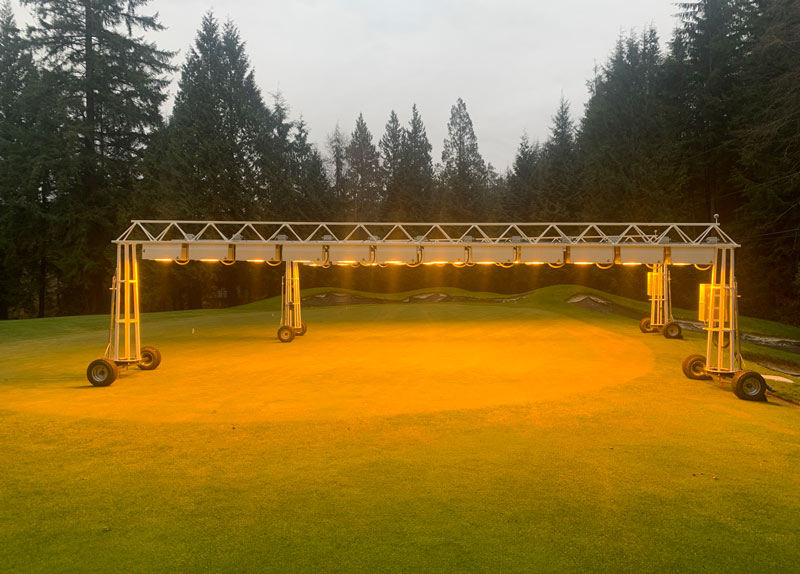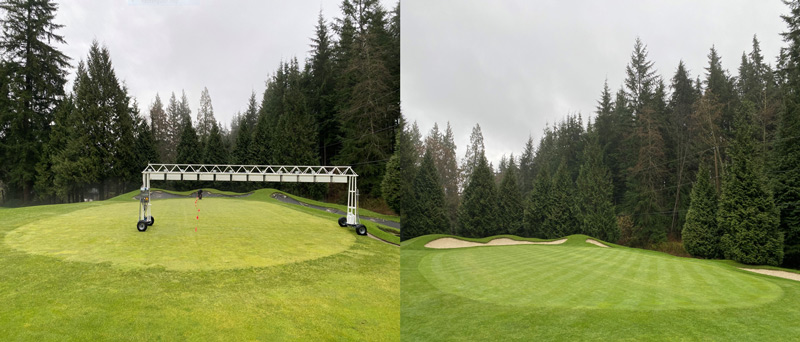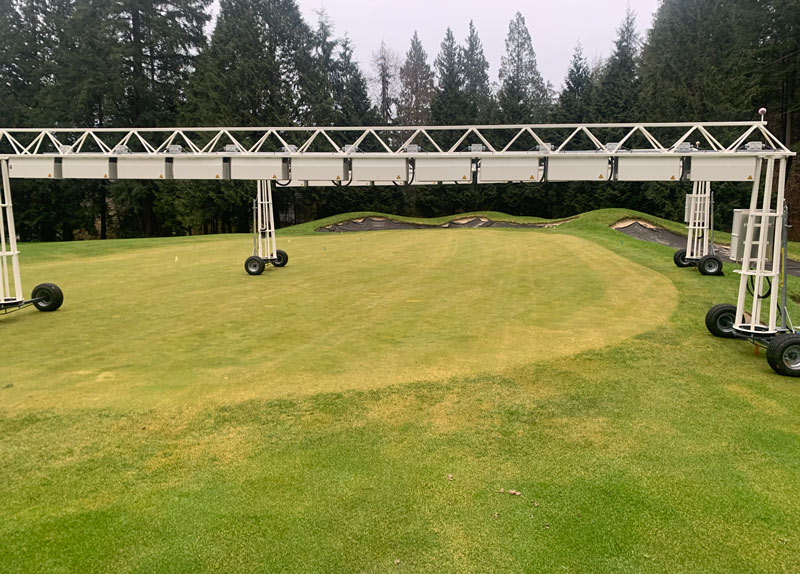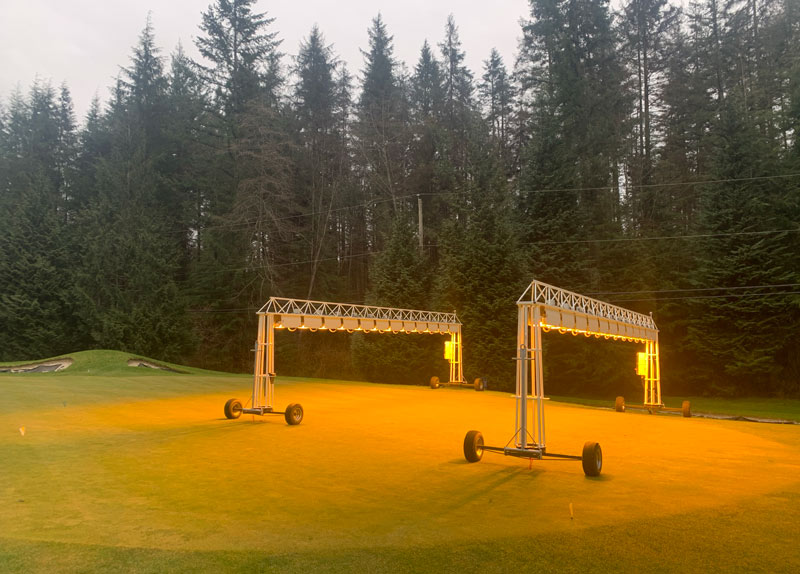
Here comes the (simulated) sun: For the second year, grow lights are accelerating green-up on No. 7 at Capilano Golf and Country Club in West Vancouver, British Columbia. Photos courtesy of Stu Sheridan
Stu Sheridan would be among the first to admit his latest method of dealing with a seasonally light-starved green wouldn’t fly just anywhere.
“I think it’s a specific solution for a specific problem,” says Sheridan, superintendent at Capilano Golf and Country Club in West Vancouver, British Columbia, and a nine-year GCSAA member. “It all depends on what other people’s situations are.”
Sheridan’s situation certainly is specific.
Shielded by mountains from the cooler interior and warmed by the westerly ocean breezes, Capilano G&CC stays open year-round. Well, most of it does. Capilano’s pesky No. 7 green gets almost no direct sunlight for four-plus months, so from late October to early March, the pure Poa annua green is closed, and golfers are forced to putt out on a temporary green.
“It goes effectively dormant,” Sheridan says. “No growth is happening on that one green.”
Even when the crew opens it for play in late March, it is babied along, mowed higher than the rest of the greens until it’s healthy enough to be treated like the other 17 — usually around mid- to late April.
The seventh green has been an ongoing problem at Capilano, one that Sheridan inherited when he became superintendent three years ago. The obvious solution would involve tree removal — a common enough practice elsewhere on the tree-lined, mountainside course — but the trees throwing shade on No. 7 are not on the course’s property.
“Removal,” Sheridan says, “isn’t an option.”

Growing pains: The shady situation on Capilano G&CC’s seventh green.
A lightbulb went off as Sheridan mulled his light plight. He recalled hearing about large-scale grow lights employed on soccer pitches, mostly overseas, and wondered whether there might be a golf course application. He’d also heard about a club in London using the lights on its greens. Sheridan reached out to one of the companies that provides the lights — Netherlands-based SGL — and arranged for two of the 30-foot lights to be delivered in early February 2021.
“The way it worked out, we were supposed to get them shipped from Amsterdam, but the logistics were really difficult for them,” Sheridan says.
Fortunately for the Capilano crew, a U.S. distributor in Columbus, Ohio — home of Major League Soccer’s Columbus Crew SC, which has enlisted similar grow lights as the technology has made inroads in North America — had two unused grow lights available to transport the 2,500 miles (or 4,000 kilometers, eh?) to West Vancouver.
Sheridan flipped the proverbial switch in February 2021, and the lights ran eight to nine hours per day for four weeks.
“The green, especially in the last week, really greened up, and we were able to open it on March 20,” Sheridan says. “It was in really, really good condition. We were mowing at the same height of cut, and the members were really impressed with how it came out of winter compared to previous years.”
Editor’s note: How much light is enough light for your turf, and how can you best measure it? Check out What the Tech? Measuring light for healthier turf.
Sheridan speculates SGL’s eagerness to break into the North American golf market made its terms quite Capilano-friendly. Essentially, the club covered the costs of shipping and infrastructure, like cabling and the rental cost for the “huge” diesel generator that powers the lights, and SGL waived the rental fee.
“The company was willing to do that to see if they work here,” Sheridan says. “I think they saw it as a way to get into the Canadian and North American golf course market.”

The seventh green at Capilano G&CC on Feb. 22, 2021 (left), before the grow lights were given a go, and post-regimen on March 20, 2021.
The test was so successful, Sheridan was eager to see whether the results could be replicated — or even improved — this year. The lights went on in January, a month ahead of last year.
“I’m really eager to see if we can match or even come out ahead of last year,” Sheridan says.
Capilano is paying a rental fee this year, Sheridan says, but that fee will be taken off the purchase price if the club opts to buy.
The lights aren’t particularly cheap. Each unit would cost about $21,000 (U.S.), so $42,000 for the pair. Sheridan rents the massive three-phase diesel generator for about $3,000 per month, and fuel runs another $1,000 every six weeks. Sheridan would prefer a more plug-and-splay approach, but electric provider B.C. Hydro only delivers single-phase power to the course.
“A generator gives us some flexibility,” says Sheridan, who ballparked a price tag of $20,000 to $25,000 to purchase an appropriate used generator. “Last winter, we had a crazy amount of golf. With a generator, if you have a weaker green or weaker part of a green, you can move a light to help. A generator gives us that flexibility to move to other sites.”
The units themselves are easily managed, Sheridan says. The closed No. 7 green is covered under a tarp at night. Each morning, a crew member removes the tarp and sets up the lights, which run eight or nine hours per day. Every four days, they’re rotated among four zones on the green to ensure equal coverage.
“One person can easily roll the lights on and off the green,” Sheridan says. “It’s about a 15- to 20-minute tear-down.”
Sheridan anticipates an irrigation system overhaul in the next few years that he says might allow a three-phase upgrade that would do away with the need for the generator.
“It would be nice to have something in the ground you can plug a cable into,” he says. “That’s not doable on most golf courses. Soccer pitches, yes. Golf courses, no.”


In 2021, for the first time, Capilano G&CC’s seventh green required no labor-intensive special treatment to reach the same quality as the club’s other putting surfaces. Superintendent Stu Sheridan is hoping for the same success this year.
The large-scale grow lights are becoming more popular in North America. Once found almost exclusively on European pitches — London’s Tottenham Hotspur Stadium in 2018 became the first stadium with an integrated, full-pitch mobile grow light system — they’ve started popping up in North America. SGL counts the Houston Dynamo, the Los Angeles Galaxy, Toronto FC and Sporting Kansas City as just some of its MLS clients, along with major league baseball’s Houston Astros and Seattle Mariners (“We initially thought we might work out a deal with them for their lights,” Sheridan says of the Mariners, who play ball less than 200 miles from Vancouver). The Kansas City Chiefs and Green Bay Packers are among the players of that other type of football that also use SGL, as do a few colleges, among them Duke and Tennessee.
Based on the outcome of this winter’s trial, Capilano G&CC may well become the next on that client list.
“I think, if we even just replicate what we did last year, if we can open that green in the middle to the end of March with it in the same condition as the rest of the greens, I’d be inclined to say yes, we should purchase them,” Sheridan says. “The reaction from the members last year was, they were happy.
“We always get comments about that green, about what we can do about it. There really is no other option. If this weren’t an option, we’d probably have to go down the route of doing a shade analysis, talking to the District of West Vancouver about permission to remove trees, which it seems they have no interest in allowing. And the trees are only getting bigger. There are no guarantees. This has worked well for us so far, and hopefully that will be the case again this year.”
Andrew Hartsock is GCM’s managing editor.